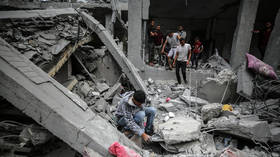If Not Oswald, Who Killed President Kennedy and Why?
by Donald W. Miller, Jr., MD, Lew Rockwell:
 I was 23 years old when President Kennedy was killed. Now, 55 years later I am most likely the only person still alive who personally knew the two physicians who figure most importantly in the case, Admiral George Burkley, Kennedy’s physician, and Dr. Malcolm Perry, the surgeon who performed a tracheotomy on him after he was shot.
I was 23 years old when President Kennedy was killed. Now, 55 years later I am most likely the only person still alive who personally knew the two physicians who figure most importantly in the case, Admiral George Burkley, Kennedy’s physician, and Dr. Malcolm Perry, the surgeon who performed a tracheotomy on him after he was shot.
When I was a teenager my father and our family and Dr. Burkley and his family shared a duplex at the Newport Naval Hospital in Newport, Rhode Island, where then Capt. George Burkley, M.D. was Chief of Medicine and my father, Capt. Donald Miller, M.D. was Chief of Surgery. I remember Dr. Burkley as a pleasant man, a straight arrow Naval officer like my father.
Dr. Burkley’s son George and I were the same age and we became buddies. One time we sailed up Narragansett Bay in his 16-foot sailboat and camped out on a small uninhabited island. That night, unknown to us, a hurricane warning was issued and early the next morning our fathers had a Navy launch come and tow us back home.
Admiral Burkley filled out Kennedy’s Death Certificate. He wrote, “A second wound occurred in the posterior back at about the level of the third thoracic vertebra.”—T3, that’s 5½ to 6 inches below the neck. He flew back from Dallas on Air Force One with the body and was at the autopsy.
Military pathologists performed the autopsy at the National Naval Medical Center in Bethesda, MD. The whole-body chart (front and back), for marking the scars and wounds on the body places the bullet wound in the back at the T3 level, as in the Death Certificate. Dr. Burkley signed the chart, writing “Verified” above his signature.
The Single Bullet Theory
The Warren Commission recognized that the single bullet theory was the only way a lone assassin firing from behind Kennedy could have killed him. Oswald only had time to fire three shots. One hit the street and grazed a bystander, and one bullet hit Kennedy in the head. So, the third bullet had to account for all the other injuries JFK and Governor Connally sustained.
The bullet holes in JFK’s shirt and jacket were likewise 5¾ inches below the collar
With a bullet shot from the sixth floor of the building behind him, it would have had to turn upward at a considerable angle to exit his neck, and then turn downward to go through Connally’s chest, fracturing a rib; next shattering his wrist, with pieces of the bullet left behind on X-ray and finally landing in his left thigh. The Warren Report blamed a near unscathed bullet found on a stretcher at Parkland Hospital for all those injuries (Commission Exhibit 399).
No bullet could transit the neck without hitting any bony structures as a CT scan of the neck will show, especially one coming out the middle of his throat. An autopsy X-ray of JFK’s neck showed no bone trauma.
At a news conference after the assassination Acting Press Secretary Malcolm Kilduff said: “Dr. Burkley told me, it is a simple matter… of a bullet right through the head.” Questioned, he stated, “It is my understanding [from Dr. Burkley] that it entered in the temple, the right temple.”
In an interview at the Kennedy Library in 1967, when asked how many bullets struck Kennedy Burkley replied, “I would not care to be quoted on that.” Ten years later, in 1977, he offered to explain to Richard Sprague, Chief Counsel of the House Select Committee on Assassinations (HSCA), why there must have been more than one shooter. But he once again clammed up when Sprague got fired wanting to conduct a no-holds-barred investigation. Dr. Burkley did, however, sign an Affidavit for the HSCA, which states that the casket was constantly observed and not opened or disturbed in its trip to the National Naval Medical Center autopsy laboratory in Bethesda, Maryland. It reads:
“I travelled from Andrew’s Air Force Base in the ambulance with the President’s body to the Bethesda Naval Hospital and accompanied the [bronze Dallas] coffin to the autopsy laboratory and saw the body removed from the coffin and placed on the autopsy table.”
Admiral Burkley lied. The bronze Dallas casket was opened and was empty when it arrived at the autopsy lab.
Douglas Horne, in his book Inside the Assassination Records Review Board: The U.S. Government’s Final Attempt to Reconcile the Conflicting Medical Evidence in the Assassination of JFK (1,804 pages in 5-volumes, 2009) shows that there were indeed three JFK casket entries to the Bethesda Naval autopsy lab that evening.
Men in suits emerging from a black hearse delivered the corpse to the autopsy lab at 6:35 pm in a body bag placed inside a cheap aluminum shipping casket. Next, Secret Service agents brought the now empty 400 lb. Bronze Dallas casket into the lab at 7:17 pm. Then at 8:00 pm, with Jackie and Bobby Kennedy walking alongside it, a military honor guard carried the Dallas casket into the autopsy laboratory, Kennedy’s corpse back inside it, once again wrapped in sheets.
Sgt. Roger Boyajian’s written report proving that Kennedy’s corpse arrived in the autopsy lab an hour-and-a-half before its official time-of-entry is the “smoking gun” in the medical evidence.
Loading...




